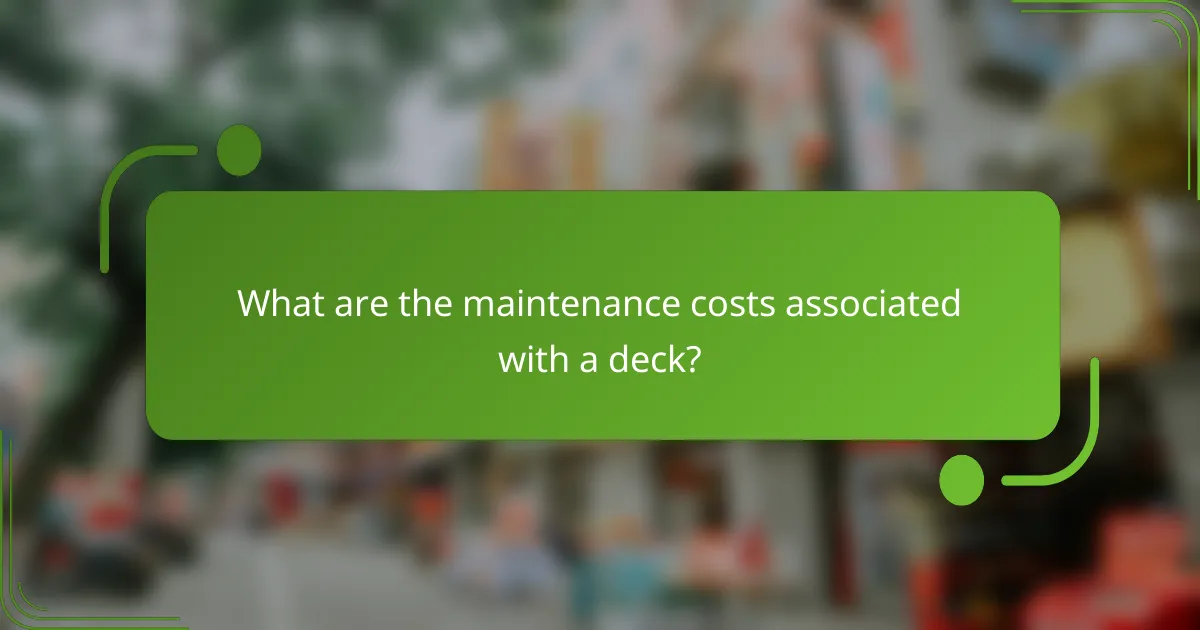Adding a deck to your home can enhance outdoor living space and potentially increase property value, but it’s important to understand the associated costs and return on investment (ROI). In the UK, deck additions typically range from several thousand to over ten thousand pounds, influenced by materials and design. Homeowners can expect to recoup 60% to 80% of their investment upon selling, making it a worthwhile consideration. Additionally, various financing strategies, such as home equity loans and personal loans, can help manage the costs effectively.

What is the cost of a deck addition in the UK?
The cost of a deck addition in the UK typically ranges from several thousand to over ten thousand pounds, depending on various factors such as materials, size, and design complexity. Homeowners should consider these elements carefully to ensure they stay within budget while achieving their desired outdoor space.
Average cost range
The average cost of a deck addition in the UK usually falls between £3,000 and £10,000. Basic wooden decks tend to be on the lower end of this range, while composite or custom-designed decks can push costs higher. Additional features like built-in seating or lighting can further increase the overall expense.
Factors affecting cost
Labour costs also play a significant role; hiring a professional contractor can increase expenses, while DIY projects may save money but require time and skill. Always consider the long-term maintenance costs associated with different materials as well.
Regional price variations
The cost of deck additions can vary significantly across different regions in the UK. Urban areas, particularly London, often see higher prices due to increased demand and higher living costs. In contrast, rural regions may offer more competitive pricing, but availability of skilled labour can be a concern.
It’s advisable to obtain multiple quotes from local contractors to understand the specific pricing landscape in your area. This approach helps ensure you get the best value for your investment while considering regional differences in material and labour costs.

What is the potential ROI of a deck addition?
The potential ROI of a deck addition can vary significantly based on factors like location, materials, and market conditions. Generally, homeowners can expect a return of around 60% to 80% of their investment when selling their property after adding a deck.
Average ROI percentage
The average ROI percentage for a deck addition typically falls between 60% and 80%. This means that if you invest £10,000 in building a deck, you could potentially increase your home’s value by £6,000 to £8,000. The exact return can depend on the quality of materials used and the overall design.
Market trends in the UK
In the UK, the demand for outdoor living spaces has grown, particularly in urban areas where private gardens are limited. Homebuyers are increasingly looking for properties with attractive outdoor features, which can enhance the appeal and marketability of a home. This trend suggests that investing in a deck could yield a favorable ROI in the current market.
Impact on property value
A well-designed deck can significantly enhance your property value, making it more attractive to potential buyers. Factors such as location, size, and materials can influence how much value a deck adds. For instance, a high-quality composite deck may add more value than a basic wooden one, particularly in upscale neighborhoods.

What financing strategies are available for deck additions?
Several financing strategies can help homeowners fund deck additions, including home equity loans, personal loans, and credit card financing. Each option has its own benefits and considerations, making it essential to evaluate which aligns best with your financial situation.
Home equity loans
Home equity loans allow homeowners to borrow against the equity they have built in their property. Typically, lenders will offer loans up to 80% of the home’s appraised value minus any existing mortgage balance. This type of financing often comes with lower interest rates compared to other options, making it a cost-effective choice for larger projects like deck additions.
However, it’s crucial to consider that your home serves as collateral, which means failure to repay could lead to foreclosure. Additionally, closing costs and fees may apply, so it’s wise to calculate the total cost of borrowing before proceeding.
Personal loans
Personal loans are unsecured loans that can be used for various purposes, including home improvements like deck additions. These loans typically have fixed interest rates and repayment terms ranging from a few years to several years, providing predictable monthly payments.
While personal loans do not require collateral, they may come with higher interest rates than home equity loans. Borrowers should compare offers from multiple lenders to find the best rate and terms. Additionally, maintaining a good credit score can help secure more favorable loan conditions.
Credit card financing
Using credit cards for financing a deck addition can be a quick solution, especially if you have a card with a low interest rate or a promotional 0% APR offer. This option allows for flexibility in payments, but it’s essential to be cautious about accumulating debt.
High-interest rates on credit cards can lead to significant costs if the balance is not paid off quickly. It’s advisable to create a repayment plan to avoid interest charges and ensure that the debt does not become unmanageable. Consider using credit cards only for smaller expenses or as a temporary solution while securing more stable financing.

What are the key considerations before adding a deck?
Before adding a deck, it’s essential to consider local building regulations, design and material choices, and the timing of installation. These factors can significantly impact the project’s feasibility, cost, and overall success.
Local building regulations
Understanding local building regulations is crucial before starting a deck addition. Many municipalities require permits for deck construction, which can involve inspections and adherence to safety codes. Check with your local building authority to learn about specific requirements in your area.
Regulations may dictate the height, size, and materials used for your deck. For example, some regions have restrictions on the distance from property lines or the types of materials that can be used, especially in environmentally sensitive areas.
Design and material choices
Choosing the right design and materials for your deck can affect both aesthetics and durability. Common materials include pressure-treated wood, composite decking, and PVC, each with its own cost range and maintenance needs. For instance, while pressure-treated wood is often less expensive upfront, it may require more maintenance over time compared to composite options.
Consider the design elements that will enhance your outdoor space, such as railings, built-in seating, or lighting. These features can add to the overall cost but may also increase the deck’s functionality and appeal.
Seasonal timing for installation
The timing of your deck installation can influence both cost and construction quality. Spring and early summer are popular times for deck building, but contractors may be busier and prices higher during these peak seasons. Conversely, late summer or fall may offer lower prices but could lead to weather-related delays.
Plan your project around the local climate to ensure optimal conditions for construction. Avoiding extreme temperatures or heavy rainfall can help ensure a smoother installation process and better long-term results.

How to choose a contractor for deck addition?
Choosing a contractor for a deck addition involves assessing their qualifications, comparing estimates, and verifying their reputation. A well-selected contractor can significantly impact the quality and cost-effectiveness of your project.
Evaluating contractor credentials
Start by confirming that the contractor is licensed and insured, which protects you from liability and ensures compliance with local regulations. Look for certifications from recognized industry associations, as these indicate a commitment to quality and professionalism.
Additionally, consider the contractor’s experience with deck additions specifically. A contractor who specializes in this type of work is more likely to understand the nuances of design, materials, and local building codes.
Comparing quotes
When comparing quotes, ensure that each estimate includes a detailed breakdown of costs, including materials, labor, and any additional fees. This transparency allows for a more accurate comparison of what each contractor offers.
Be cautious of significantly low bids, as they may indicate subpar materials or rushed work. Aim for quotes that fall within a reasonable range based on your local market; for example, deck additions can typically range from a few thousand to over ten thousand USD depending on size and materials.
Checking references and reviews
Request references from previous clients and take the time to contact them. Ask about their experience with the contractor, the quality of work, and whether the project was completed on time and within budget.
Online reviews can also provide insights into a contractor’s reputation. Look for patterns in feedback, such as consistent praise for communication or complaints about delays, to gauge reliability and customer satisfaction.

What are the maintenance costs associated with a deck?
Maintenance costs for a deck can vary significantly based on materials, usage, and climate. Regular upkeep is essential to prolong its lifespan and maintain safety, typically involving cleaning, sealing, and occasional repairs.
Annual maintenance expenses
Annual maintenance expenses for a deck generally range from a few hundred to over a thousand dollars. This includes costs for cleaning supplies, sealants, and any professional services needed. Homeowners should budget for these recurring expenses to ensure their deck remains in good condition.
For example, pressure washing can cost around $100 to $300, while sealing might add another $200 to $500 annually, depending on the deck’s size and material.
Long-term repair considerations
Long-term repair costs can accumulate if maintenance is neglected. Common issues include rotting wood, loose boards, and rusted hardware, which may require significant investment to fix. Homeowners should inspect their decks regularly to catch problems early, potentially saving on larger repair bills later.
For instance, replacing rotting wood can cost anywhere from $300 to $1,500, depending on the extent of the damage and the type of wood used.
Material durability impacts
The choice of decking material significantly influences maintenance costs. Composite materials often require less upkeep than traditional wood, which may need more frequent sealing and repairs. Homeowners should weigh the initial investment against long-term maintenance when selecting materials.
For example, while pressure-treated wood is less expensive upfront, it may incur higher maintenance costs over time compared to composite options, which can last longer with minimal care.
